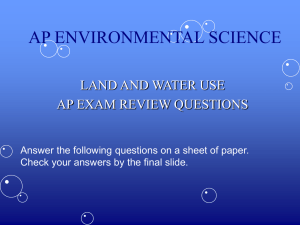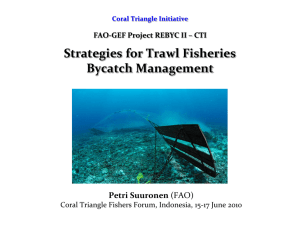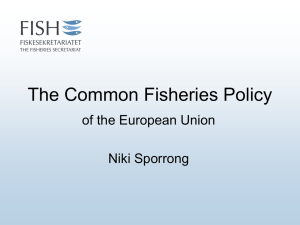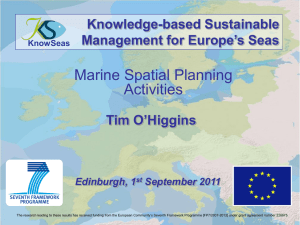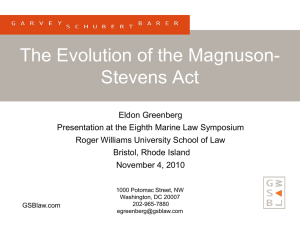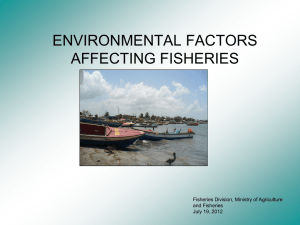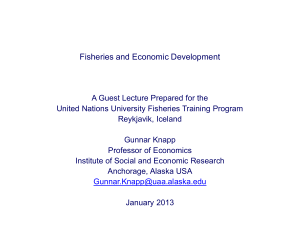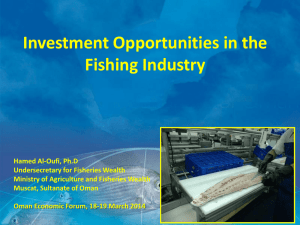SWNM.sustainable fisheries guide: sustainability without the hot air
advertisement
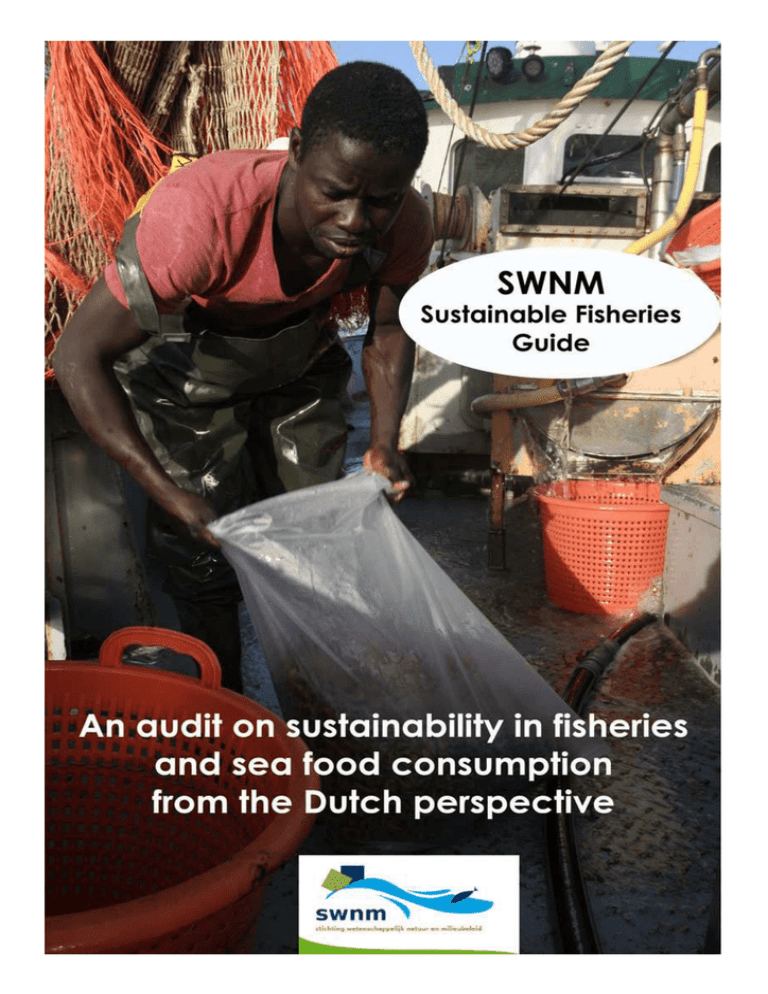
Sustainable Fisheries Guide, the Dutch perspective Sustainable Fisheries Guide, the Dutch perspective CONTENT 1. What is sustainability? 2. What does sustainability mean in fisheries management? 3. What is Maximum Sustainable Yield? 4. Are the oceans empty in 2048? 5. Is the popular ‘fishing down the foodweb’-concept a valid description of reality? 6. Are fisheries always the most important influence on the health of fish stocks? 7. Is fish from aquaculture more sustainable than wild caught North Sea white fish? 8. What is ecological sustainability in fisheries perspective? 9. Is the MSC-label the only standard for sustainable fishing? 10. Are consumerguides on sea food by NGO’s based on scientific criteria? 11. How sustainable is Dutch Sea Food consumption? The SWNM – Foundation for a Scientific Nature & Environmental Policy- is a grassroots Dutch NGO supported by fishermen who endorse environmental policies based on verifiable facts and knowledge of fisheries practices. It promotes a view of sustainable use of natural resources based on sound biology. The SWNM advisory board consists of academics with a life-time experience in fisheries biology and research. The SWNM was founded in 2002 by the Dutch farmer Jan van de Geest. His cows were poisoned by sewage overflow, released from the sewer to surface waters by the Dutch Waterboard in episodes of high rainfall. Van de Geest filed a complaint to the Waterboard, but was ridiculed by government officials and many of his opponents. After all, he was ‘only a farmer’. Van de Geest won his courtcase by issuing independent academic research on water quality, motivated by his dedication to factfinding and truth. After Van de Geest received compensation by the Waterboard, the problems of water pollution by sewage overflow came high on the national agenda. www.swnm.nl Text, research and images: www.rypkezeilmaker.nl, nature/sciencewriter ©2014 Reviewed by dr. P. Hagel, dr A. Corten & dr. D. Boddeke Sustainable Fisheries Guide, the Dutch perspective 1. What does sustainability mean? The word sustainability in environmental context – ‘Nachhaltigkeit’ - was first used in 1713 in German forestry by Hans Carl von Carlowitz in his epic work Silvicultura: ‘to observe a level of conservation and growth of wood, so that continuous and sustainable harvest (‘Nachhaltige Nutzung’) is obtained’. Though many agenda-driven opinions on ‘sustainability’ circulate in media, the most common modern definition is derived from the Brundtland Report ‘Our Common Future’ in 1987: ‘Sustainable development seeks to meet the needs and aspirations of the present without compromising the ability to meet those of the future.’1 The definition contains two key concepts: ‘needs’ of people and ‘limits’ to meet these needs. These limits are not absolute and imposed by the environment on one hand, and on the other hand the level of social organisation and technology to overcome these limits. In the environmental debate of the last 40 years two simplified positions can be identified: ‘alarmists’ motivated by a precautionary approach on one hand stress the limits of a system, so that needs must be restrained by top down governmental measures. ‘Optimists’ underline human ingenuity as ‘the ultimate resource’2 to overcome environmental limits with bottom up, free market solutions, so that all growing needs can be met3. 2. What does sustainability mean in fisheries management? Often the famous ‘Tragedy of the Commons’-concept- introduced by ecologist Garrett Hardin in 1968- is mentioned in relation to fisheries. Individual freedom to maximise profit leads to depletion of common resources, unless enclosures (social limits/physical barriers) are imposed. Since the start of industrial fisheries fish stocks in open ocean are seen as common resources which are depleted through (unlimited) exploitation. In the Brundtland-report the UNCLOS declaration from 1981 is hailed as a successfull example of international cooperation in managing fish stocks (‘commons’), by installing Economic Exclusive Zones (EEZ), which function as enclosures. UNCLOS hands nations a legal instrument to restrict access of foreign fishing fleets to fishing grounds in their EEZ. At present, sustainability of fisheries varies highly among regions4. According to a 2009 study which identified 6 criteria for assessing fisheries sustainability, of which the possibility for nations to restrict access of foreign fleets is an important part. Countries like New Zealand qualify as the most sustainable fisheries, partly due to this advantage.5 The EU scores average on sustainability Since introduction of the Common Fisheries Policy in 1987, EU-nations give up exclusive access to national fishing grounds and use an inter-tradable quota-system, not only based on scientific advise- one of 6 defining criteria for sustainable fisheries policies- but also political deals. The productivity of the ocean for fisheries is environmentally limited by elements like phosphorous and iron6 for primary producers. This is the base of the foodweb. Some technical solutions have been proposed to increase productivity of marine ecosystems through phosphorous-78 to enhance food supply through yield of sea food products, or iron-fertilisaton for climate mitigation9. 1 Gro Harlem Brundtland red. (1987) ‘Our Common Future’, report of the World Commission on Environment and Development, pg 37, point 1, and pg 34, point 49: Far from requiring the cessation of economic growth it regognizes that the problems of poverty and underdevelopment cannot be solved unless we have a new era of growth in which developing countries play a large role and reap large benefits.. and pg 15 point 27: It also states about limits: ‘not absolute limits but limitations imposed by the present state of technology and social organisation on environmental resources and by the ability of the biosphere to absorb the effects of human activities.’ 2 The late economist Julian Simon and his successor Bjorn Lomborg 3 In ‘The Closing Circle’ in 1972 biologist Barry Commoner outlines various positions in the environmental debate after ‘Earth Day’ of which today’s positions are modern equivalents. 3 In the modern environmental debate the two positions are reflected by Mark Lynas (‘sensible alarmist’) and Matt Ridley (‘rational optimist’) 4 Worm B, et al. (2009) Rebuilding global fisheries. Science 325:578–585 5 Mora, C., Myers, R. A., Coll, M., Libralato, S., Pitcher, T. J., Sumaila, R. U., Zeller, D., Watson, R., Gaston, K. J. & Worm, B. 2009. Management Effectiveness of the World's Marine Fisheries. PLoS Biol, 7, 1 - 11 6 Liebig’s law of the minimum states that the most scarce element needed by primary producers to optimise photosynthesis is the limiting element, in some cases phosphorous or iron. 7 Boddeke, R. en Hagel, P. 1995. Eutrophication, fisheries, and productivity of the North Sea continental zone. In Armantrout, NB, en Wolotira, R.J, Condition of the world´s aquatic habitats. Proceedings of the World Fisheries Congres, Theme 1, Oxford IBH Publishing Co. Pvt. Ltd. New Delhi. P 290/315 8 Maricult Research Project in Norway 2002 enhanced productivity of a Norse fjord by phosphorous fertilisation 9 Iron fertilisation is now seen as a geo-engineering solution to enhance CO2-uptake by primary producers for climate mitigation Sustainable Fisheries Guide, the Dutch perspective 3. What is Maximum Sustainable Yield? Most publications on the state of world fisheries use Maximum Sustainable Yield (MSY) as an indicator for sustainability. MSY is reached at a harvest level of (depending on species) 60-70 percent of the reproductive part of the population (the spawning stock biomass (SSB) of an unfished stock.10 MSY is an economic reference point- first used in policy in the ‘50s. A stock that is fished above MSYlevel contains more small faster growing individuals that support more fishermen with less revenues per catch. A stock fished under MSY contains bigger slower growing fish that support less fishermen with higher revenues per catch. The concept of MSY is under criticism by fisheries biologists, for as a single species management tool it does not take into account interactions among species: if cod in the North Sea would be fished at MSY-level, than it’s prey species like herring would suffer higher predation rates, and thus these fisheries would have lower yields, or reach levels below MSY. The concept of MSY is also under criticism by social scientists.11 Nevertheless, the European Commission aims for MSY for al species under quota in 2015. 4. Are the oceans fished empty in 2048? NGO’s like Greenpeace claim that oceans will be fished empty in 2048- a sentence derived from a press release accompanying the Worm 2006 12 -study that went viral in media. What activists/journalists (who did not read the study) overlooked, was that Worm focussed on biodiversity effects on productivity of marine systems, not overfishing. Worm predicted stock collapses based on a correlation of negative biodiversity trends and productivity, but with negative 10 Hilborn R (2010) Pretty good yield and exploited fishes. Marine Policy 34:193–196. C. Finley & N. Oreskes 2013 –Maximum sustained yield: a policy disguised as science – ICES Journal of Marine Science, 70(2): 245 – 250 12 Worm B. (2006) Impacts of biodiversity loss on ocean ecosystem services, Science 314, 787 ‘Our data highlight the societal consequences of an ongoing erosion of diversity that appears to be accelerating on a global scale (Fig. 3A). This trend is of serious concern because it projects the global collapse of all taxa currently fished by the mid–21st century (based on the extrapolation of regression in Fig. 3A to 100% in the year 2048)’. The sentence was put on top of the press release. 11 Sustainable Fisheries Guide, the Dutch perspective trends still reversible. A ‘collapse’ is identified as a catch level per effort that is 10 percent or less of the historic maximum catch.13 In the less hyped Worm/Hilborn study in Science in 200914 that focussed on fisheries sustainability, Rebuilding Global Fisheries’ the largest assessment was made of the current status of global fisheries until date. Of the assessed 166 stocks, 63 percent were below MSY with 37 percent of stocks in a continued state of overfishing (with 14 percent collapsed), and 28 percent on a trajectory of recovery. Of the stocks 37 percent was at MSY or had recovered to MSY. The study revealed considerable regional variation in stock trends and management effectiveness per country. The most important target species for Dutch fisheries, plaice and herring, are fished at MSY-level. 15 Due to the high reproductive ability of many fishing stocks, management measures can be effective in a relatively short time16. 5. Is the fishing down the foodweb-concept a valid description of reality? In 1998 Daniel Pauly launched the idea that fishermen would first target large predatory fish, and after depleting these stocks would fish down lower trophic levels in the foodweb, until only jellyfish remain. The underlying rationale of Pauly’s concept was that large predatory fish like tuna would be of more commercial value, and thus be targeted heavier. However, evidence points in a different direction: crustaceans (low in the foodweb) on average bring 39 percent more financial yield than predatory fish high in the foodweb: a conclusion that can be validated by every consumer visiting the fishmarket. Thus other scientists concluded that not the trophic level in the foodweb but profitability of a species is the driver of (over)fishing efforts17, 13 R. Froese, K. Kesner-Reyes, Impact of Fishing on the Abundance of Marine Species [ICES Council Meeting ReportCM 12/L:12, International Council for the Exploration ofthe Sea (ICES), Copenhagen, Denmark, 2002]. 14 Worm B, et al. (2009) Rebuilding global fisheries. Science 325:578–585 15 http://ec.europa.eu/fisheries/cfp/fishing_rules/tacs/info/com_2012_278_en.pdf 16 Hilborn, R, Kearney, B. (2012) Australian Seafood consumers misled by prophets of doom, 17 Sethi SA, Branch TA, Watson R (2010) Global fishery development patterns are driven by profit but not trophic level. Proc Natl Acad Sci USA 107:12163–12167 Sustainable Fisheries Guide, the Dutch perspective The Fishing Down-concept is now rejected by fisheries biologists18 as a valid way of describing causes and effects of (over)fishing. It remains popular among some NGO’s who warn the public that fishermen first catch the biggest fish until only jellyfish remain.19 Pauly’s claims gained credit in media after a study by Boris Worm in 2003 claimed 90 percent of tuna-SSB was depleted since the start of industrial fisheries in the ‘50s. This claim has been tuned down by a 2011 study to (depending on tuna-species) 50-60 percent, with the most heavily fished but fastest growing and reproducing Skipjack tuna still at MSY-level.20 6. Are fisheries always the most important influence on the health of fish stocks? In many occasions environmental factors like nutrient availability and changes in climate play a larger role in the decline of stocks, that were/are attributed to ‘overfishing’: Eg; the lack of recovery of the collapsed cod-stocks at ‘Cape Cod’ is now more attributed to environmental factors like climate than fisheries21. The decline of cod stocks after the eighties and it’s lack of recovery in the South Eastern North Sea has been attributed to the decline in nutrient availability, due to environmental policies regulating the phosphorous load in the Rhine.22 7. Is white fish from aquaculture more sustainable then wild caught fish? NGO’s and governmental advisory bodies often narrow their concept of sustainability to the limits the world’s climate would put on human economic patterns, with (fossil) energy use as sole indicator of sustainability. An example of this narrow approach is the study ‘Environmental Performance of Wild Caught North Sea White Fish’ by the Dutch government advisory body LEI: it concluded that imported fish from aquaculture from pe Vietnam was as sustainable as wild caught white fish from Dutch fisheries, based on a comparison of it’s ‘Global Warming Potential’(= fuel use).23 But, from the perspective of environmental limits relevant for marine ecosystems- CO2-emission is the least applicable indicator for assessing the sustainability of fisheries, and may be chosen because fuel use is the easiest indicator to assess24. In 2004 the Dutch North Sea fishing fleet used 2-3 percent of all tanked shipping fuel, resulting in an estimated CO2-emission of 1,13 Megaton CO2, which is one fifth of the emissions of one coal plant of 1100 Megawatt at 7000 operating hours (5,8 Megaton CO2). From 2003-2013 of the Dutch fleet 84 ships were decommissioned leading to a fleet of 300 ships in 2012, which were also 45 percent more economic on fuel. So with the resulting CO2-emission of 0,48 Megaton CO2, the fleet’s emissions were 1/12th of one coal plant of which The Netherlands now has six operating. 8. What is ecological sustainability? Single species MSY is unable to assess larger ecosystem effects on species composition by fishing. Evidence suggests great effects of ‘predator release’ due to fisheries, with pelagic species (+143 percent) and invertebrates (+26 percent) as the winners after biomass of shark, tuna, cod and skates is removed25. Fishing creates cascade-effects, and evidence in the Pacific suggests that mid-trophic 18 Branch, T. A., Watson, R., Fulton, E. A., Jennings, S., McGilliard, C. R., Pablico, G. T., Ricard, D. & Tracey, S. R. 2010. The trophic fingerprint of marine fisheries. Nature, 468, 431 - 435. 19 The Greenpeace Brochure ‘A Healthy Sea full of Fish’2013 ( in Dutch) literally quotes Daniel Pauly’s remarks in 2003 20 Juan-Jordá, M. J., Mosqueira, I., Cooper, A. B., Freire, J. & Dulvy, N. K. 2011. Global population trajectories of tunas and their relatives. Proceedings of the National Academy of Sciences of the United States, 108, 20650 - 20655 21 5. Rothschild, B. J. Coherence of Atlantic cod stock dynamics in the northwest Atlantic Ocean. Trans. Am. Fish. Soc. 136, 858-874 (2007). Hilborn, R. & Litzinger, E. Causes of decline and potential for recovery of Atlantic cod populations. The Open Fish Science Journal2, 32-38 (2009) Halliday R. G. & Pinhorn, A. T. The roles of fishing and environmental change in the decline of Northwest Atlantic groundfish populations in the early 1990s. Fisheries Research 97, 163-182 (2009). 22 Boddeke, R. en Hagel, P. 1995. Eutrophication, fisheries, and productivity of the North Sea continental zone. In Armantrout, NB, en Wolotira, R.J, Condition of the world´s aquatic habitats. Proceedings of the World Fisheries Congres, Theme 1, Oxford IBH Publishing Co. Pvt. Ltd. New Delhi. P 290/315 23 S.W.K. van den Burg C. Taal I.J.M. de Boer T. Bakker T.C. Viets Environmental Performance of Wild Caught North Sea White Fish, LEI-rapport 2011-090 via http://edepot.wur.nl/192117 24 The choice might be an indicator for a lack of resources for sound science, but also governmental policy preferences: The Dutch Ministry of Foreign Affairs invests in Vietnamese aquaculture trough the CBI-institute 25 Worm B, et al. (2009) Rebuilding global fisheries. Science 325:578–585 Sustainable Fisheries Guide, the Dutch perspective level species increase in abundance with predator release from a decline in tuna.26 So while some effects of fishing may still be economically sustainable, in ecological sense they may not be. In assessing ecosystem effects of fishing on ‘ecosystem health’, larger effects on the ecosystem are taken into account and effects of declining biodiversity, as in the Worm 2006-study. Worm concluded that current negative trends on biodiversity and productivity are not irreversible27 . Marine ecosystems are more resilient than terrestrial ecosystems that recover more quickly after a perturbation. Quick recovery after perturbation is one defining criterion of ecosystem health28. In a metastudy on 236 papers on ecosystem recovery29 it was found that marine ecosystems on average recover within 10 years (measured in productivity) after overfishing, while forest ecosystems took 50 years on average. 9. Is the MSC-label the only standard for sustainable fishing? Ecolabels are needed in a global market to trace the origin and thus sustainability of products, when doubt exists on the product’s origins. In the Mora et al study in Plos Biology, sustainability in fisheries is highly related to 6 criteria leading to effectiveness of government policy30. Not to private standards developed by NGO’s and industry, which are applied mostly in the territorial waters of countries with more effective fisheries policies. MSC was founded by Unilever and WWF in 1998 to guarantee Unilever a constant supply of fish from Canada and Alaska, after worries of stock collapse entered media. At this moment 7 percent of all fisheries are labelled with MSC. Other competing ecolabels are Friends of the Sea and Alaska Seafood, the latter using the region of origin as it’s ‘sustainability’-qualification. Though MSC is regarded as a high quality ecolabel, criticism focuses on it’s high costs which prohibits small scale fisheries of an MSC-sustainability label. 26 Polovina J, Abecassis M, Howell EA, Woodworth P (2009) Increases in the relative abundance of mid-trophic level fishes concurrent with declines in apex predators in the subtropical North Pacific, 1996-2006. Fish Bull 107:523–531 27 Worm B. (2006) Impacts of biodiversity loss on ocean ecosystem services, Science 314, 787 28 SWNM Bodemwijzer en SWNM- MPA-Wijzer, via kenniscentrum www.swnm.nl , en Jake Rice pers comm. 29 Jones H.P. and O.J. Schmitz. 2009. "Rapid Recovery of Damaged Ecosystems." PLoS One 4(5): e5653 30 Mora, C., Myers, R. A., Coll, M., Libralato, S., Pitcher, T. J., Sumaila, R. U., Zeller, D., Watson, R., Gaston, K. J. & Worm, B. 2009. Management Effectiveness of the World's Marine Fisheries. PLoS Biol, 7, 1 - 11 Sustainable Fisheries Guide, the Dutch perspective 10. Are consumerguides on sea food by NGO’s based on scientific criteria? Fishguides by NGO’s like WWF reflect personal preferences and the will to market the MSC-label, not scientific criteria. As fisheries biologists Ray Hilborn and Bob Kearney write for Australian Fish market31: … There are 16 or more different organisations in Australia that produce ‘guides’ of various forms that are intended to influence public opinion on the environmental responsibility of consuming different seafood species. There are no standards or government regulation of the efficacy of these guides or their impact on the seafood industry they are designed to influence. There are no minimum qualifications or standards of experience required of the people who do the assessments of individual seafood species on which these guides are based. For example, the Dutch Fish Guide (Viswijzer) by WWF and the North Sea Foundation- which advises consumers on sustainable fish consumption- places North Sea plaice in ‘red’- a no consumption advice- while plaice is fished at MSY for years and quota have been expanded in 2013 with 30 percent. The brown shrimp in the North Sea is qualified in orange- a no consumption advice- while fishermen recorded historical high catches. (But did not buy an MSC-label favoured by the Viswijzer) The pressure by NGO’s on supermarkets blocks the sales of potential sustainable caught fish by prohibiting non-MSC seafood at CLM, while 84 percent of sales volumes of fish products are sold at supermarkets. 11. How sustainable is the Dutch (Sea) Food consumption? The Dutch are meateaters, and consume 20 times more pork, beef and chicken than sea food products (3,4 kilograms per inhabitant per year)32, while according to Hilborn and Kearney33 wild caught fish may be more sustainable through the absence of the use of anti-biotics and pollution. Most fish products are bought in the supermarket (84 percent) where deep frozen ‘fish sticks’ are the 31 Hilborn, R, Kearney, B. (2012) Australian Seafood consumers misled by prophets of doom, voor Australian Fish Market 32 http://www.pve.nl/wdocs/dbedrijfsnet/up1/ZkfdylwII_432680PVEpromoNL_LR_definitief.pdf , 33 Hilborn, R, Kearney, B. (2012) Australian Seafood consumers misled by prophets of doom, voor Australian Fish Market Sustainable Fisheries Guide, the Dutch perspective most sold product (pollack from Canada and Alaska), pangasius from Vietnam and skipjack tuna from the Pacific. Of ‘fresh’ sold fish, the number 1 is salmon from aquaculture in Norway, Scotland and Chile. While the most popular fresh fish from the Dutch North Sea ranks at 8 in the top ten of most consumed fish. The Dutch consumption-level of 3,4 kilo per inhabitant levels half of the Dutch herring-quota in 201334. Dutch fisheries on plaice could cover two third of the Dutch consumption volume of fish products, but most plaice is exported to Southern Europe and Germany. 34 http://www.pvis.nl/fileadmin/user_upload/pvis/Documenten/Publicaties/Viris_visquota_2013.pdf
